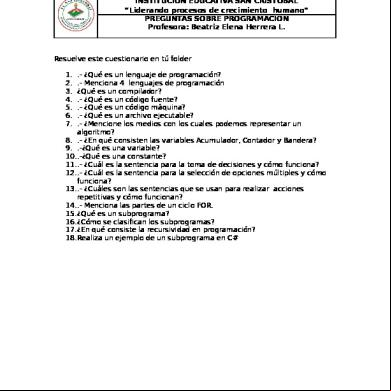The Imp Of The Mind - Obsessions And Compulsions 4t1m22
This document was ed by and they confirmed that they have the permission to share it. If you are author or own the copyright of this book, please report to us by using this report form. Report 2z6p3t
Overview 5o1f4z
& View The Imp Of The Mind - Obsessions And Compulsions as PDF for free.
More details 6z3438
- Words: 1,206
- Pages: 4
The Imp of the Mind: Exploring the Silent Epidemic of Obsessive Bad Thoughts By Lee Baer, Ph.D.
The “Imp of the Perverse,” as Poe described it. o “We perpetrate them merely because we feel that we should NOT.”
Visits everyone from time to time with one of two outcomes:
1. We give little attention to the thoughts and move on. 2. We are strongly affected by the bad thoughts, causing them to occur more and interfere with functioning
To cure the bad thoughts, one must understand one key fact
You are not so abnormal as you think. Every human being is visited from time to time by the Imp of the Perverse, who makes you think the most inappropriate thoughts at the most inappropriate times.
This urge is universal and historical o Pandora – could not stop thinking about what she was told to forget. o Eve in the Garden of Eden
The Imp of the Perverse will try to torment you with thoughts of whatever it is you consider to be the most inappropriate or awful thing that you could do.
The thing we imagine to be the worst possible thing can and does change over time.
Exacerbating effects:
o The “thought to suppression” effect. The person tries to suppress the thought, which leads to an increase in the thoughts. o Most people suspect they are a very dark person, deep on the inside. The first appearance of the Imp of the Perverse signals an “awakening” of this evil part of the self. They then suppress, which seems logical, but results in an increase in thoughts. Bad thoughts do not signify that you are truly evil deep down, and voluntarily suppressing these thoughts will only make them stronger. The very fact that these people have not done any of the things they are worried about doing is cause for reassurance. o The best predictor of future behavior is past behavior. People for Whom These Stay Around Tend to Be: Overly conscientious and inflexible about moral and ethical issues Preoccupied with rules
Prefrontal Cortex – the guilt and distress they suffer is the result of the prefrontal cortex doing its job by energetically suppressing the bad thoughts. When Are Bad thoughts Dangerous? If you do not feel upset about the thoughts but instead find them pleasurable. If you have ever acted on violent or sexual thoughts or urges in the past – either while sober or under the influence of alcohol or drugs. If you hear voices, think people are against you, or see things that others do not see. If you feel uncontrollable anger and find it hard to resist urges to act on your aggressive impulses. What Causes Bad Thoughts? Evolutionary History – extravigilant mothers increased chances of their offspring’s survival and ed down their hypervigilant genes to future generations. When Problems Arise 1.) They cannot accept that such thoughts are part of being human, 2.) They fear their orbital-frontal cortex will not be able to inhibit their thoughts and urges. Why Bad thoughts Get Out of Control Depression Tourette’s Syndrome – ECD and Tourette’s Syndrome are thought to be genetically linked and to share neurological pathways. OD – “sensitive conscious” OCD o They are unable to pay sufficient attention to events that are not actively focusing on. o As a result, these events are not stored in their memories, as happens automatically for most of us. o This is why it doesn’t in their minds that they have done something, like turn off the light switch. May stare at the switch – it hasn’t ed for them. o This is why they can’t feel certain that they haven’t done something inappropriate, because they can not not having done it. o Being conscientious, they search memory for proof of not doing it, but in vain. o They then conclude that they must have done the terrible thing. Brain Imagery When people think bad thoughts specific parts of the brain become more active: orbital-frontal cortex, caudate nucleus, anterior cingulum – all part of the limbic system – part of the brain associated with strong feelings. This is why people obsess about things involving danger or humiliation. A truly dangerous person’s brain acts exactly opposite – that part of the brain is underactive. Visual Images Some people report actually seeing images of what they fear happening. o Clearly not psychotic, but it is something like a hallucination.
o When you form a mental image in your head, you are activating exactly the same areas of the brain that would be activated is you were actually seeing the event. PTSD, not OCD The memory is of a real event. The trauma becomes encoded in an abnormal form of memory, which breaks spontaneously into consciousness as flashbacks and nightmares. Why Do People With OCD Worry So Much About Their Thoughts? Childhood: o Highly sensitive Social situation Loud sounds Strong emotions Generally shy Sensitive to being picked on by others Difficulty expressing anger towards others The Highly Sensitive Person by Dr. Elaine Aron o 15 – 20% of the population is highly sensitive to stimulation They are: 1.) highly conscientious, and 2.) often thinking about their own thinking. Exposure Therapy Expose yourself to the thing that most triggers your fear or discomfort for 1-2 hours without leaving the situation, or doing anything else to distract or comfort yourself. o This is the first nondrug treatment that shows a change in brain chemistry.
Why this works: Habituation o Similar to living near the train tracks but not “hearing” the train any more. o Children afraid of the dark: With our parents’ help, we stay in our room at night in the dark even though we are afraid. Eventually we are not afraid any more. o Through changing our behavior (staying in the dark room) we indirectly change our thoughts (monsters) and feelings (fear). Exposure: In Vivo o Have the person expose himself or herself to what they fear for one hour per day. o Audio Tape: make a script of the fear, record it on tape, o have the person listen for one hour per day. o Also when the bad thoughts come, they should listen to the tape until the thoughts stop. o They must resist distracting themselves or comforting themselves with reassuring self statements during this time. o When the tape becomes “boring” it is a good sign that treatment is working.
o The thoughts will not disappear completely. But the person can remind himself/herself that they are “just thoughts” and let them without anxiety. See page 86 for examples of In Vivo Therapy for thoughts. Cognitive Therapy o Cognitive errors can be confronted and changed. Common cognitive errors Attributing too much importance to having particular thought Thinking they need to be able to completely control their thoughts Thinking a situation is more dangerous than it really is Intolerance of uncertainty Perfectionism Excessive responsibility
The “Imp of the Perverse,” as Poe described it. o “We perpetrate them merely because we feel that we should NOT.”
Visits everyone from time to time with one of two outcomes:
1. We give little attention to the thoughts and move on. 2. We are strongly affected by the bad thoughts, causing them to occur more and interfere with functioning
To cure the bad thoughts, one must understand one key fact
You are not so abnormal as you think. Every human being is visited from time to time by the Imp of the Perverse, who makes you think the most inappropriate thoughts at the most inappropriate times.
This urge is universal and historical o Pandora – could not stop thinking about what she was told to forget. o Eve in the Garden of Eden
The Imp of the Perverse will try to torment you with thoughts of whatever it is you consider to be the most inappropriate or awful thing that you could do.
The thing we imagine to be the worst possible thing can and does change over time.
Exacerbating effects:
o The “thought to suppression” effect. The person tries to suppress the thought, which leads to an increase in the thoughts. o Most people suspect they are a very dark person, deep on the inside. The first appearance of the Imp of the Perverse signals an “awakening” of this evil part of the self. They then suppress, which seems logical, but results in an increase in thoughts. Bad thoughts do not signify that you are truly evil deep down, and voluntarily suppressing these thoughts will only make them stronger. The very fact that these people have not done any of the things they are worried about doing is cause for reassurance. o The best predictor of future behavior is past behavior. People for Whom These Stay Around Tend to Be: Overly conscientious and inflexible about moral and ethical issues Preoccupied with rules
Prefrontal Cortex – the guilt and distress they suffer is the result of the prefrontal cortex doing its job by energetically suppressing the bad thoughts. When Are Bad thoughts Dangerous? If you do not feel upset about the thoughts but instead find them pleasurable. If you have ever acted on violent or sexual thoughts or urges in the past – either while sober or under the influence of alcohol or drugs. If you hear voices, think people are against you, or see things that others do not see. If you feel uncontrollable anger and find it hard to resist urges to act on your aggressive impulses. What Causes Bad Thoughts? Evolutionary History – extravigilant mothers increased chances of their offspring’s survival and ed down their hypervigilant genes to future generations. When Problems Arise 1.) They cannot accept that such thoughts are part of being human, 2.) They fear their orbital-frontal cortex will not be able to inhibit their thoughts and urges. Why Bad thoughts Get Out of Control Depression Tourette’s Syndrome – ECD and Tourette’s Syndrome are thought to be genetically linked and to share neurological pathways. OD – “sensitive conscious” OCD o They are unable to pay sufficient attention to events that are not actively focusing on. o As a result, these events are not stored in their memories, as happens automatically for most of us. o This is why it doesn’t in their minds that they have done something, like turn off the light switch. May stare at the switch – it hasn’t ed for them. o This is why they can’t feel certain that they haven’t done something inappropriate, because they can not not having done it. o Being conscientious, they search memory for proof of not doing it, but in vain. o They then conclude that they must have done the terrible thing. Brain Imagery When people think bad thoughts specific parts of the brain become more active: orbital-frontal cortex, caudate nucleus, anterior cingulum – all part of the limbic system – part of the brain associated with strong feelings. This is why people obsess about things involving danger or humiliation. A truly dangerous person’s brain acts exactly opposite – that part of the brain is underactive. Visual Images Some people report actually seeing images of what they fear happening. o Clearly not psychotic, but it is something like a hallucination.
o When you form a mental image in your head, you are activating exactly the same areas of the brain that would be activated is you were actually seeing the event. PTSD, not OCD The memory is of a real event. The trauma becomes encoded in an abnormal form of memory, which breaks spontaneously into consciousness as flashbacks and nightmares. Why Do People With OCD Worry So Much About Their Thoughts? Childhood: o Highly sensitive Social situation Loud sounds Strong emotions Generally shy Sensitive to being picked on by others Difficulty expressing anger towards others The Highly Sensitive Person by Dr. Elaine Aron o 15 – 20% of the population is highly sensitive to stimulation They are: 1.) highly conscientious, and 2.) often thinking about their own thinking. Exposure Therapy Expose yourself to the thing that most triggers your fear or discomfort for 1-2 hours without leaving the situation, or doing anything else to distract or comfort yourself. o This is the first nondrug treatment that shows a change in brain chemistry.
Why this works: Habituation o Similar to living near the train tracks but not “hearing” the train any more. o Children afraid of the dark: With our parents’ help, we stay in our room at night in the dark even though we are afraid. Eventually we are not afraid any more. o Through changing our behavior (staying in the dark room) we indirectly change our thoughts (monsters) and feelings (fear). Exposure: In Vivo o Have the person expose himself or herself to what they fear for one hour per day. o Audio Tape: make a script of the fear, record it on tape, o have the person listen for one hour per day. o Also when the bad thoughts come, they should listen to the tape until the thoughts stop. o They must resist distracting themselves or comforting themselves with reassuring self statements during this time. o When the tape becomes “boring” it is a good sign that treatment is working.
o The thoughts will not disappear completely. But the person can remind himself/herself that they are “just thoughts” and let them without anxiety. See page 86 for examples of In Vivo Therapy for thoughts. Cognitive Therapy o Cognitive errors can be confronted and changed. Common cognitive errors Attributing too much importance to having particular thought Thinking they need to be able to completely control their thoughts Thinking a situation is more dangerous than it really is Intolerance of uncertainty Perfectionism Excessive responsibility










